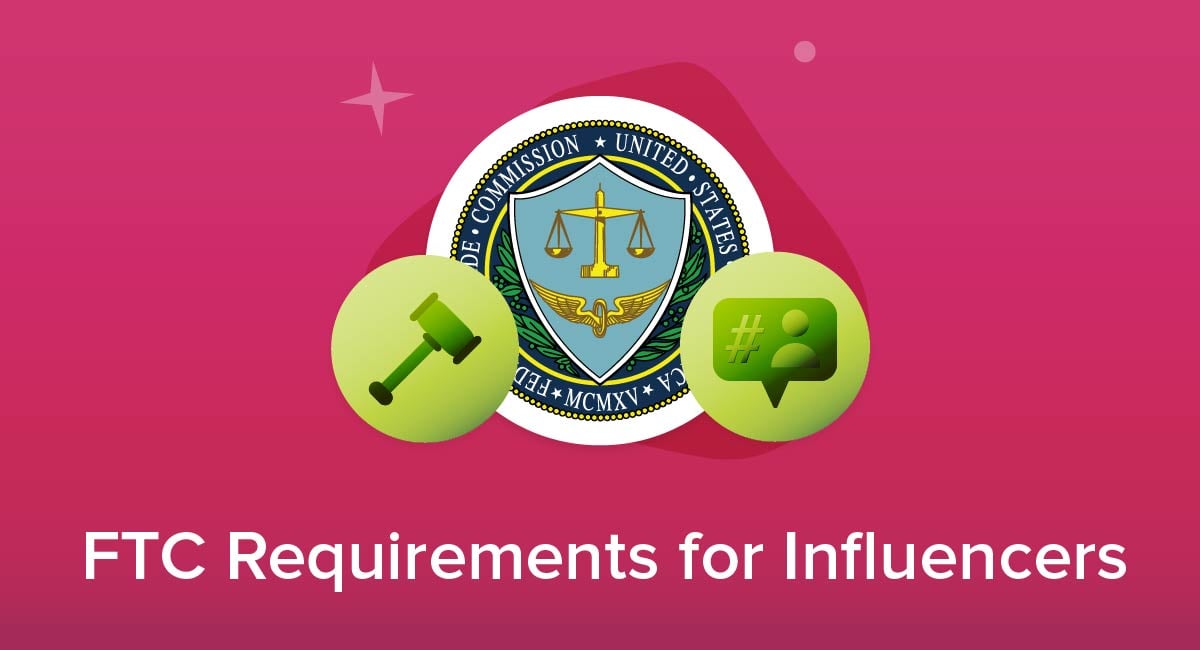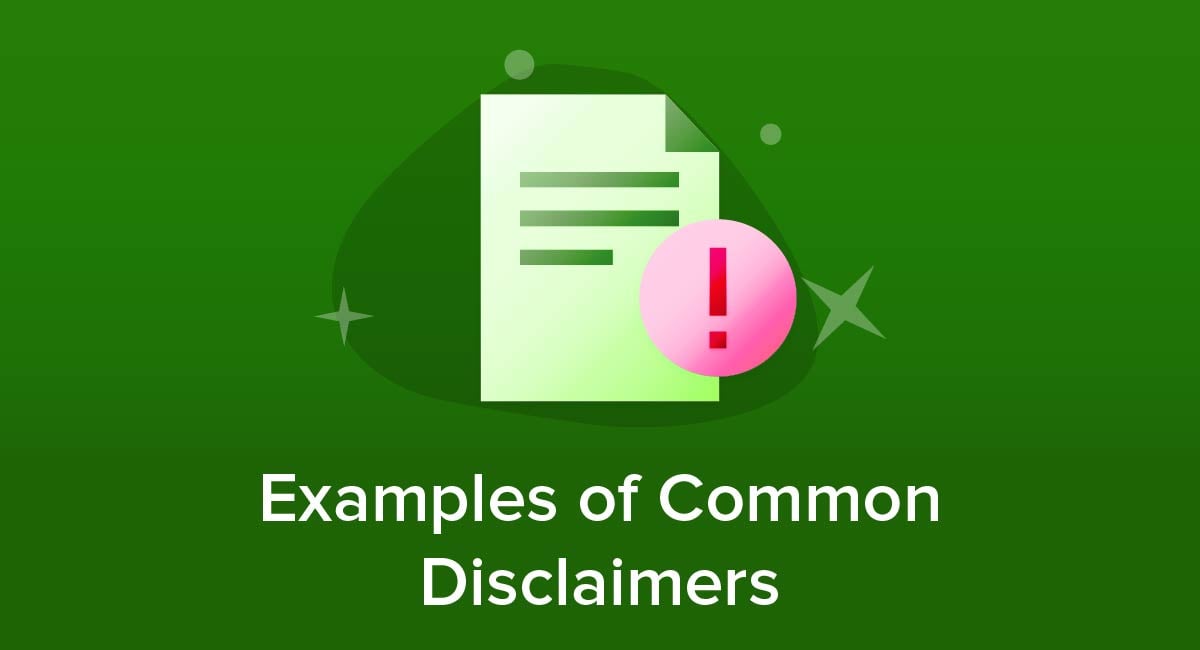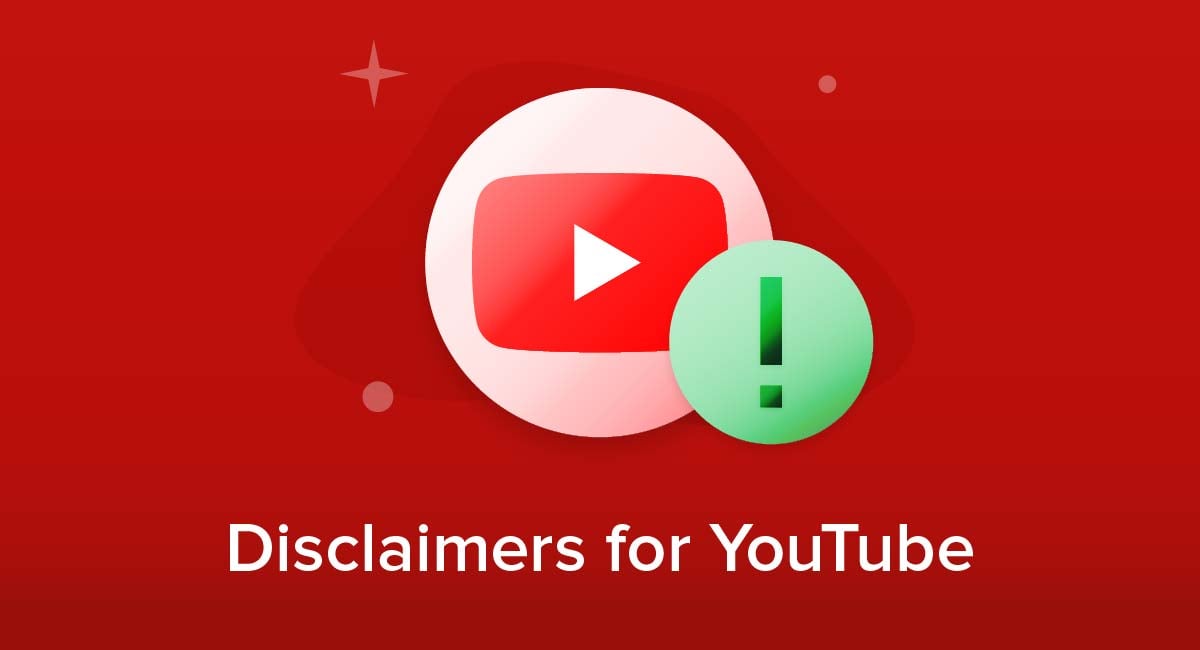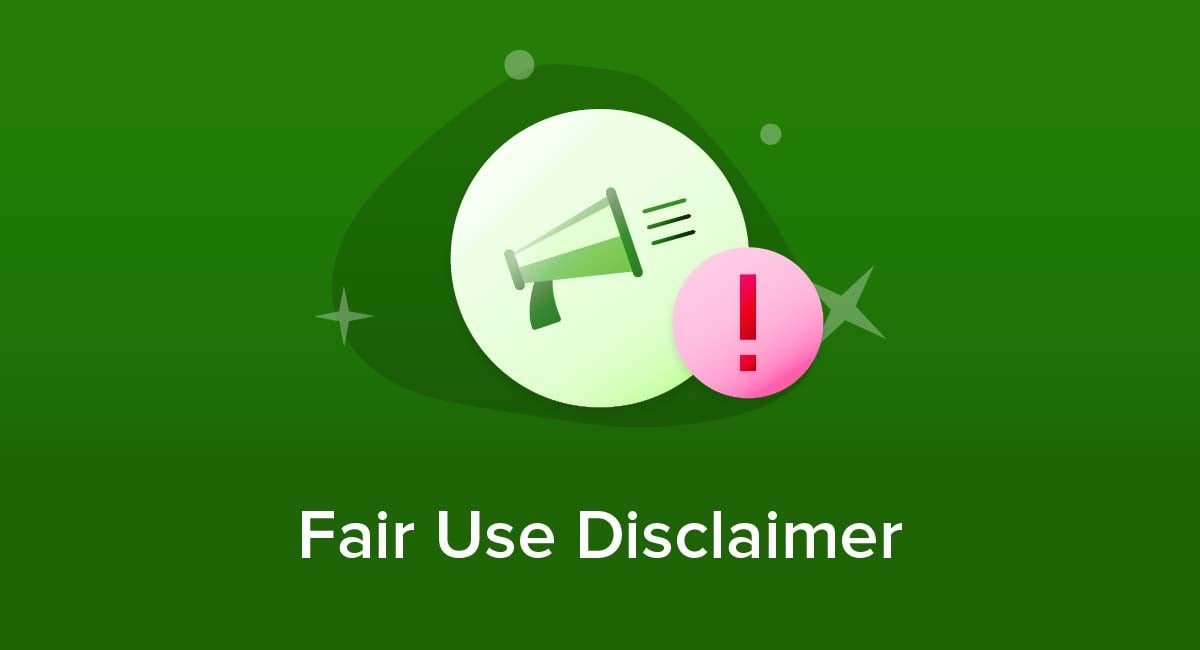
Reproducing somebody else's content isn't always against copyright law. In some cases you can use a brief extract for specific purposes under "fair use" rules.
A fair use disclaimer makes it clear to the public and authorities that you are relying on these rules while acknowledging the copyright holder's ownership and rights.
Here's what you need to know about what fair use disclaimers are, why you should have one, and how you can create and display your own.
Our Free Disclaimer Generator is designed to help you comply with the requirements of various affiliate programs, such as Amazon Associates. It also includes various disclaimers like medical disclaimer, fitness disclaimer, website disclaimer and so on.
Just follow these few simple steps and generate a Free Disclaimer for your site or your app:
- Start by choosing the "Free Disclaimer Generator" on our site.
-
Then select where your Disclaimer will be used on:
-
Follow with adding your website/app information:
-
Enter the country and click on the "Next Step" button:
-
Continue with building your Disclaimer and answer on questions about your business from our wizard:
-
Now just enter your email address where you'd like your Disclaimer sent and click on the "Generate" button.
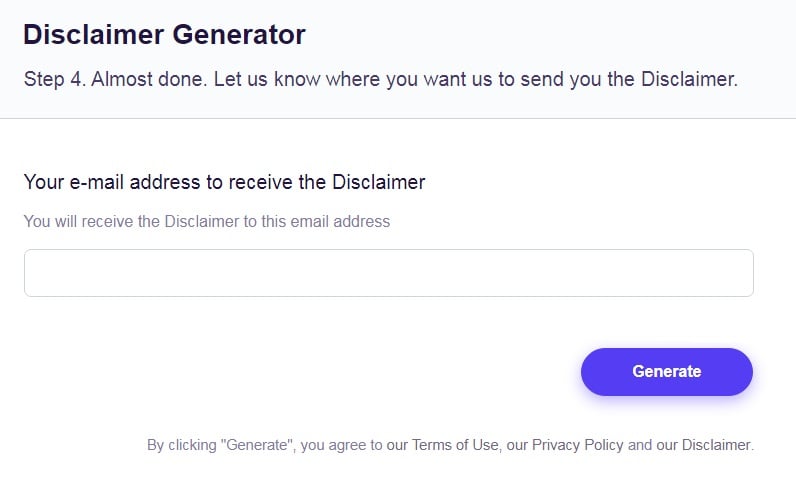
You're done! You can copy and paste your Disclaimer code into your website/app, or link to your hosted Disclaimer page.
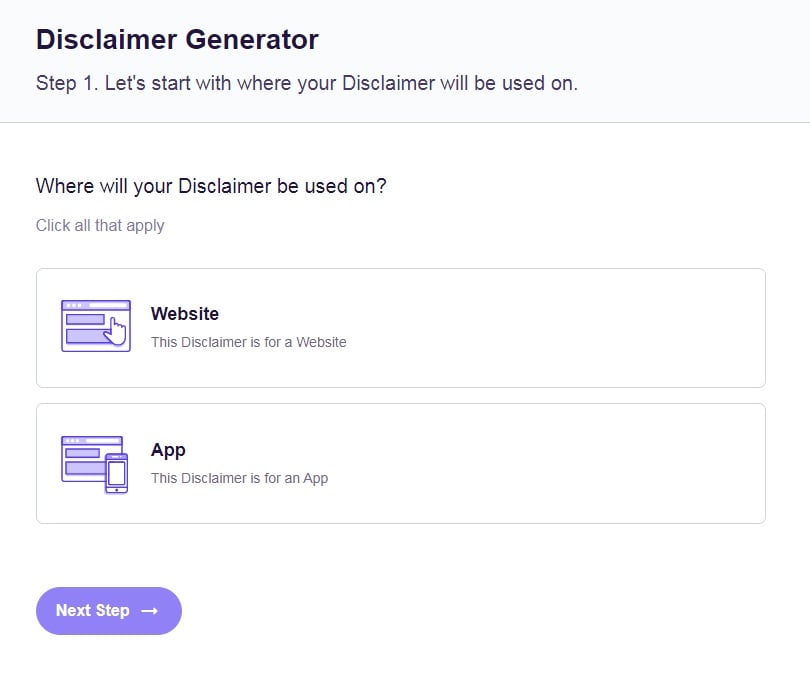
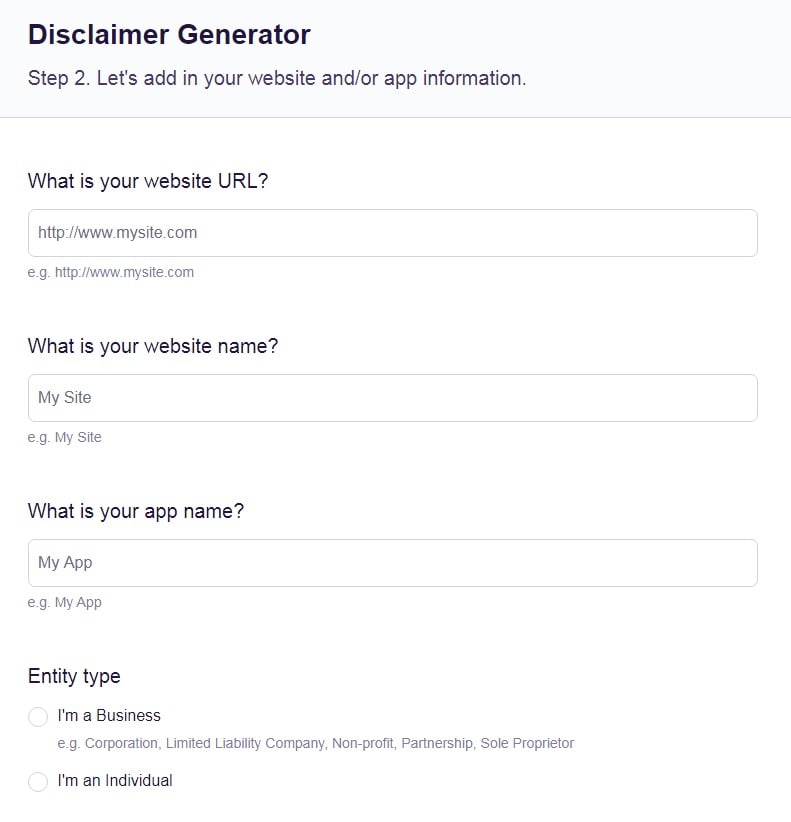
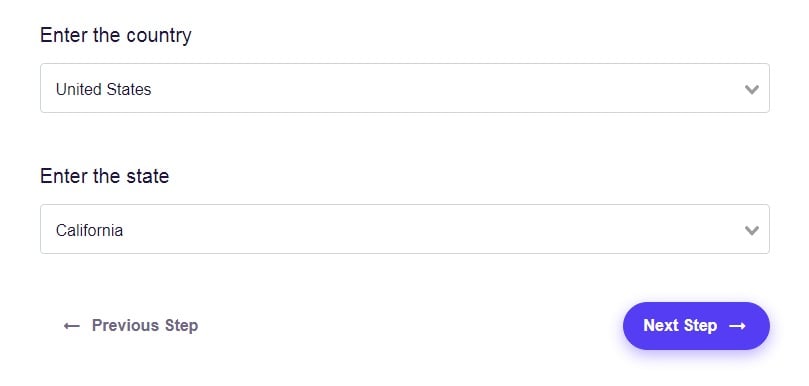
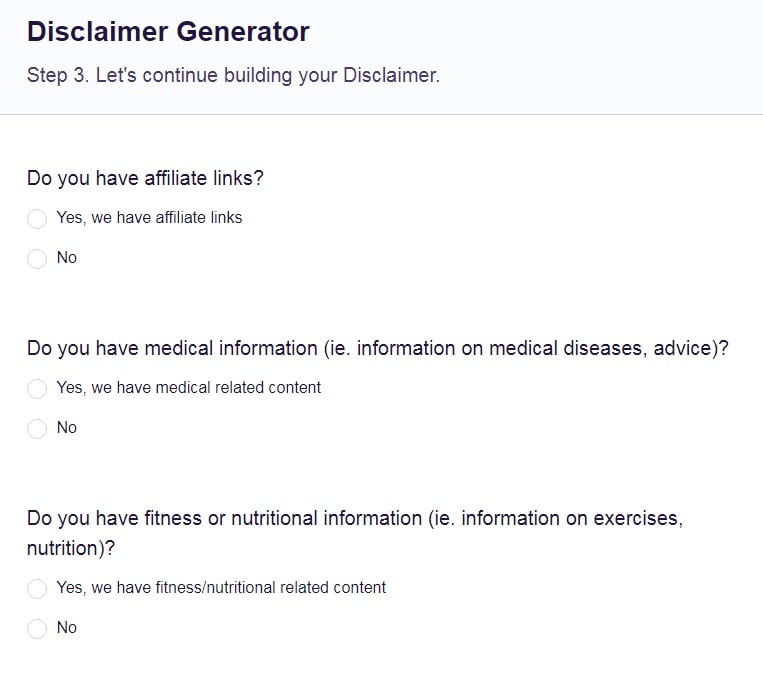
- 1. What is Fair Use?
- 2. What is a Fair Use Disclaimer?
- 2.1. Do You Need a Fair Use Disclaimer?
- 3. How to Write a Fair Use Disclaimer
- 3.1. Acknowledge that Material is Copyrighted
- 3.2. Explain That You are Relying on Fair Use
- 3.3. Cite Specific Fair Use Rule
- 3.4. Justify Fair Use
- 3.5. Discourage Copyright Abuse
- 4. Where to Display a Fair Use Disclaimer
- 4.1. Specific Placement
- 4.2. Site-Wide Disclaimer
- 5. Summary
What is Fair Use?
Fair use refers to the legal use of copyrighted materials for narrow and defined purposes
Almost every country has copyright laws that give people rights over the content they create. Most commonly, these laws cover creative work such as writing, audio or video.
Copyright laws usually say the creator has the exclusive rights to use the copyrighted material for a set period. Reproducing the copyrighted material without permission can lead to a claim for copyright violation and damages.
However, most copyright laws have an exemption called "fair use." This exemption means it is legal to reproduce the copyrighted material without permission in specific circumstances.
These circumstances commonly include the following:
- Using the material for educational purposes or research
- Using the material for news reporting or commentary
- Using the material for other transformative purposes, meaning you add something new or use the material in a different way
Fair use can be a gray area where it's hard to have completely objective and defined boundaries. In the United States, the relevant section of law for fair use exemptions is U.S. Copyright Law, 17 USC Section 107.
The U.S. law establishes fair use as a legal right and cites four factors as deciding whether a particular situation counts as fair use:
- The purpose and character of the use, including whether such use is of a commercial nature or is for nonprofit educational purposes
- The nature of the copyrighted work
- The amount and substantiality of the portion used in relation to the copyrighted work as a whole.
- The effect of the use upon the potential market for or value of the copyrighted work
These points are not a straightforward checklist. Only a court can make a definitive decision on whether something counts as fair use, and it will weigh up all of these factors.
A key principle to remember is that if a case does go to court, the burden is on the copyright holder to prove they hold the copyright and that you have used the material without permission. However, if you then rely on the fair use exemption, the burden is on you to prove fair use applies.
What is a Fair Use Disclaimer?

A fair use disclaimer is a publicly-displayed statement that declares that you are using copyrighted material, but that you are using it under the doctrine of fair use. It will explain briefly what fair use is, and often cites the relevant law.
Do You Need a Fair Use Disclaimer?
There's no specific law requiring a fair use disclaimer. If you are challenged over your use of copyright material, you could still put forward a fair use defense even if you did not publish a disclaimer.
However, you should use a fair use disclaimer when you use copyrighted material that falls under fair use for the following reasons:
- It reduces the likelihood of the copyright holder taking action against you for an alleged violation. They will know that you have considered the legal situation and will rely on fair use as a defense in any court case. They will also find it harder to argue that you have either acted recklessly, or intentionally violated copyright.
- It makes clear to third parties that the material is protected by copyright and that you are not the copyright holder. This reduces the risk that you appear to be encouraging or condoning anyone else reproducing the material in a way that does breach copyright.
Remember that a fair use disclaimer will not protect you if you have in fact violated copyright laws, for example if your claim of fair use is not legally valid.
How to Write a Fair Use Disclaimer

Your fair use disclaimer needs to include information that accomplishes two main things:
- It must declare that you are using copyrighted material, but that you are using it under the doctrine of fair use
- It should explain what fair use is
The following content is standard across fair use disclaimers and will be included in most of them.
Acknowledge that Material is Copyrighted
By acknowledging that the material in question is copyrighted, you show you are acting in good faith and not intending to breach copyright. You could explicitly use the phrase "no copyright infringement is intended," though remember this isn't a defense in itself.
Specifically explain which material is covered by the fair use. This reduces the risk of confusion and also makes clear that you hold the copyright on the remaining material.
LOSFA acknowledges the copyright situation, but this would be more effective by specifying which material it covers and who holds the copyright:
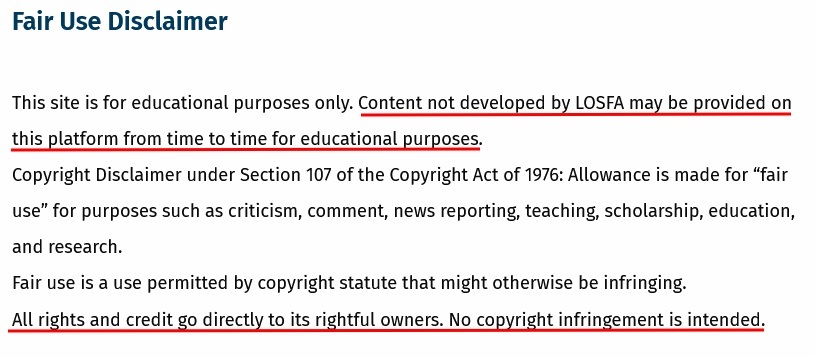
Explain That You are Relying on Fair Use
Clearly state you are using the copyrighted material on a "fair use" basis and that this is the reason you are not breaching copyright laws.
Basketball Beacon makes this statement unambiguously:
![]()
Cite Specific Fair Use Rule
In some jurisdictions "fair use" may only be a convention or principle, but in others it is explicitly set out in law. When possible, cite the section and name of the law that details the fair use rules. You could also link to it if the law is online.
This shows you have considered the law and made the effort to use copyrighted material correctly.
In the United States, the relevant statute is section 107 of the Copyright Act of 1976.
Here's how STARR Commonwealth clearly cites this in its fair use disclaimer:
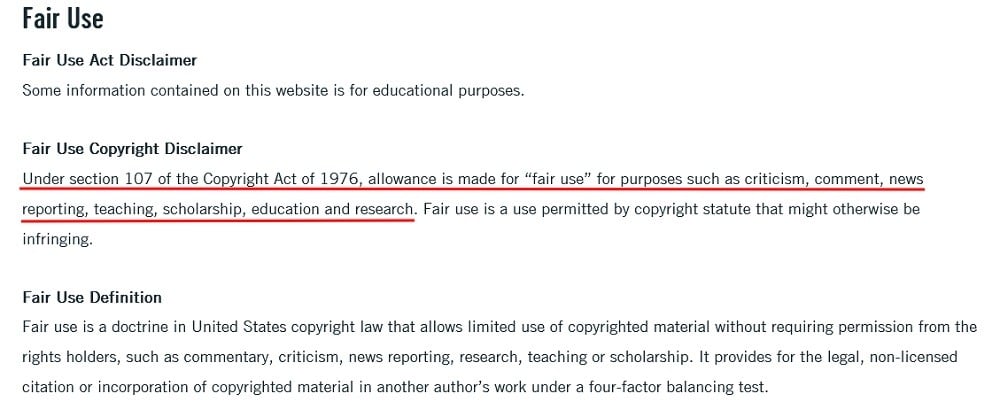
Justify Fair Use
Give clear details of why the way you have used the material counts as fair use. Remember that this could include:
- The reasons why you've used the material
- The length of the extract you've used, both as a proportion of the original material and the document in which you've used it
- The effect (or lack of effect) it could have on the copyright holder's ability to make money
The critical media project website gives specific reasons why it considers its reproduction to be fair use:
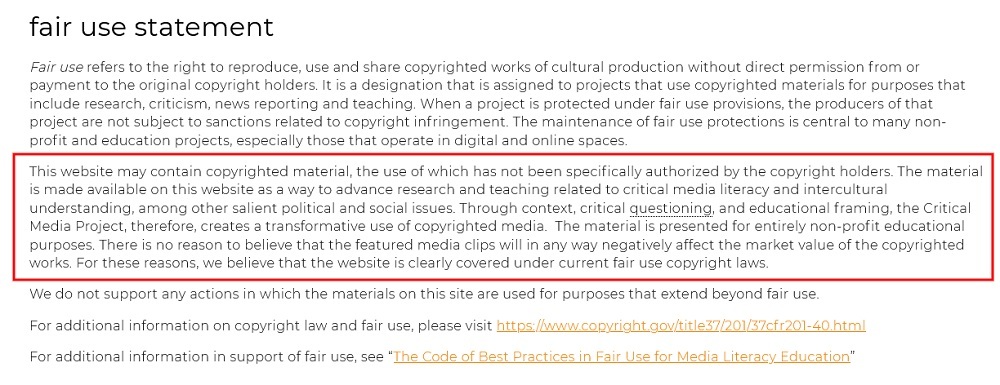
Discourage Copyright Abuse
Remind readers that they must follow copyright rules, including getting permission from the copyright holder to use the material.
Clean Air Revival makes clear that anyone wishing to use copyrighted material from its site must obtain permission first if their own use would go beyond fair use:

While you have several points to cover in your fair use disclaimer, it doesn't have to be overly long and you don't need to break it down into individual sections for each point.
Keeping the disclaimer clear and concise may help show you are being straight and not trying to hide behind legal jargon.
Where to Display a Fair Use Disclaimer

You have two main options for displaying your fair use disclaimer, though using both will often be the best approach.
Specific Placement
If you keep your disclaimer very short and concise, you can place it near each place where you use copyrighted material under the fair use exemption. This could be:
- Immediately before or after the copyrighted material
- At the bottom of the page containing the copyrighted material such as in the footer
- In the description of some types of content and media, such as videos
This YouTube description by grtjoe1901 shows how a fair use disclaimer can be displayed with a video:

Site-Wide Disclaimer
If you use copyrighted material under fair use in multiple places on your site (or expect to do so in the future) it makes sense to have a site-wide disclaimer, or one that is easily available from anywhere on the site.
You could display your fair use disclaimer in the following ways:
- As a separate, dedicated page
- As part of an overall page about intellectual property rights (including your own copyright)
- As part of a legal agreement such as a Terms and Conditions agreement
The Science at Your Doorstep site has a link from the bottom of every page pointing to a dedicated fair use disclaimer:
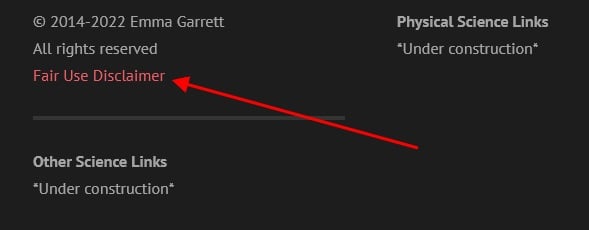
Summary
Copyright gives content creators the exclusive right to use their material for a fixed period. Using the material without permission is normally a breach of copyright and could mean having to pay damages.
However, many copyright laws contain an exemption for fair use. In the U.S., this is covered by section 107 of the Copyright Act.
Fair use usually involves using the material in a transformative way, meaning a different use and context to the original. The U.S. law uses four factors to decide if something counts as fair use:
- Why you are using the material
- The nature of the material (eg fact or fiction)
- How much of the material you use
- Whether your use affects the copyright holder's ability to make money from the material
A fair use disclaimer acknowledges the material is copyrighted and says you have used it without permission under fair use rules. It shows you respect the copyright, act in good faith and reasonably believe your use is legitimate. This may reduce the chances of the copyright holder taking action against you.
A fair use disclaimer should:
- Acknowledge that the material used is protected by copyright
- Explain that you are using the copyrighted content under fair use
- Cite the relevant law
- Justify your claim of fair use
- Discourage others from breaching copyright
You can put a specific fair use disclaimer near the copyrighted material, use a site-wide disclaimer to cover all situations, or both.
